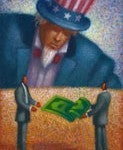Federal Reserve chairman Ben S. Bernanke’s speech Friday at the gathering of government and academic economists in Jackson Hole, Wyoming, offered strong new indications that the flailing U.S. economy will likely get new stimulus measures from the Fed.
But the measures being discussed are unlikely to have much effect on the economy, other than to artificially bolster stock and commodity prices to some extent. “I have severe doubts that this kind of monetary policy is likely to be beneficial in the long run,” says Wharton finance professor Franklin Allen, who was at the conference. “It has not been in Japan and they have now been following these kinds of policies for many years…. One of the major talking points at the conference was how little real effect all this monetary stimulus is having.”
One reason for that ineffectiveness, many believe, is that interest rates are already so low – actually negative in some cases after accounting for inflation – that further monetary easing has little impact. It’s like trying to “push on a string,” goes an expression sometimes used to explain the ineffectiveness of easing policies in today’s record-low interest rate environment.
A potential QE3 (a third round of so-called quantitative easing) will be effective, however, at distorting market prices through asset price inflation, Allens adds. “That is part of the problem as to why these actions don’t have too much in the way of real effects. They are hiding what the market is telling people…. The reason the stock market is so high at the moment is at least partly because of these interventions. Similarly with commodity prices…. They are distorting prices and not letting the market do its job.”
While no final decisions came out of the Jackson Hole symposium, some action may follow Fed meetings in mid-September. Those actions could include many or all of the following:
- more asset purchases (treasury- and mortgage-backed types of securities) to hold interest rates near today’s low levels;
- continuing (and possibly additional) forward guidance on plans to keep interest rates low;
- lower rates the Fed pays on bank reserves to boost lending; and
- lower-cost funding for some forms of lending, such as mortgage loans – which would parallel a program recently introduced by the Bank of England.
Such ongoing monetary easing can raise concerns about stoking inflation. But since the economy continues to be weak, and since QE1 and QE2 had little effect on inflation under similar conditions, inflation worries appear small. “In the short run, consumer price inflation is not likely to move up, but in the long run I think there is a risk,” Allen points out.
Instead, the biggest economic risk – with or without QE3 — is continued high unemployment.
So what should or could the Fed do to make lowering unemployment a higher priority? “This also was a big topic at the conference,” Allen says. “I don’t think there is much they can do. Arguably the government can introduce retraining policies and so forth to try and counter the long-term unemployment problem we have. But this is not a Fed policy.”
What the Fed can do is get interest rates “back to 2% so that retirees and people who are saving for retirement stop having to save so much and know that they can survive in the long run without taking excessive risk.” At present, Allen says, financial institutions are getting too many subsidies “at the expense of savers.” The government also needs a serious plan to solve the huge deficit problem long term. “We need to avoid the fiscal cliff, and we also need to avoid a fight over the debt ceiling.”
But, he adds, “I am not optimistic any of this will be done.”
Wharton professor of business economics and public policy Kent Smetters thinks QE3 is not a done deal and has just a 30% to 40% chance of going through. But even if approved, the additional liquidity would help the economy only a “little bit.” Instead, the stimulus will simply add to banks’ excess reserves, leaving banks little incentive to lend out the funds, even thoiugh new lending is supposed to be the purpose of the exercise.
In Smetters’ view, the chief problem with the economy today is a lack of business investment, and that results from the reluctance of banks to lend. “We have an investment problem.”
GDP is made up of four key components: consumer and government spending, net exports and business investment, Smetters points out. Consumer spending and net exports are at average or only slightly below average levels. “Government spending is high.” What’s really lagging is business investment, he says. The slow down in bank lending causing the dearth of investment stems from worries by banks that interest rates will soon go up and leave banks holding unprofitable loans set at today’s lower interest rates.
“Aggregate demand is low, not because of consumers, but because we are still light on investment, and Congress and the President have something to do with that,” notes Smetters. “But we are not pulling the right levers on the Fed side. They need to convince the market we are in a low-risk interest rate environment for the long term – a new normal.”
Thus, he adds, the most effective action that could come out of the recent Fed thinking is additional guidance showing that the Fed plans to keep interest rates low, not just for some specified period into the future, but until the economy shows real signs of revival, Smetters says.




